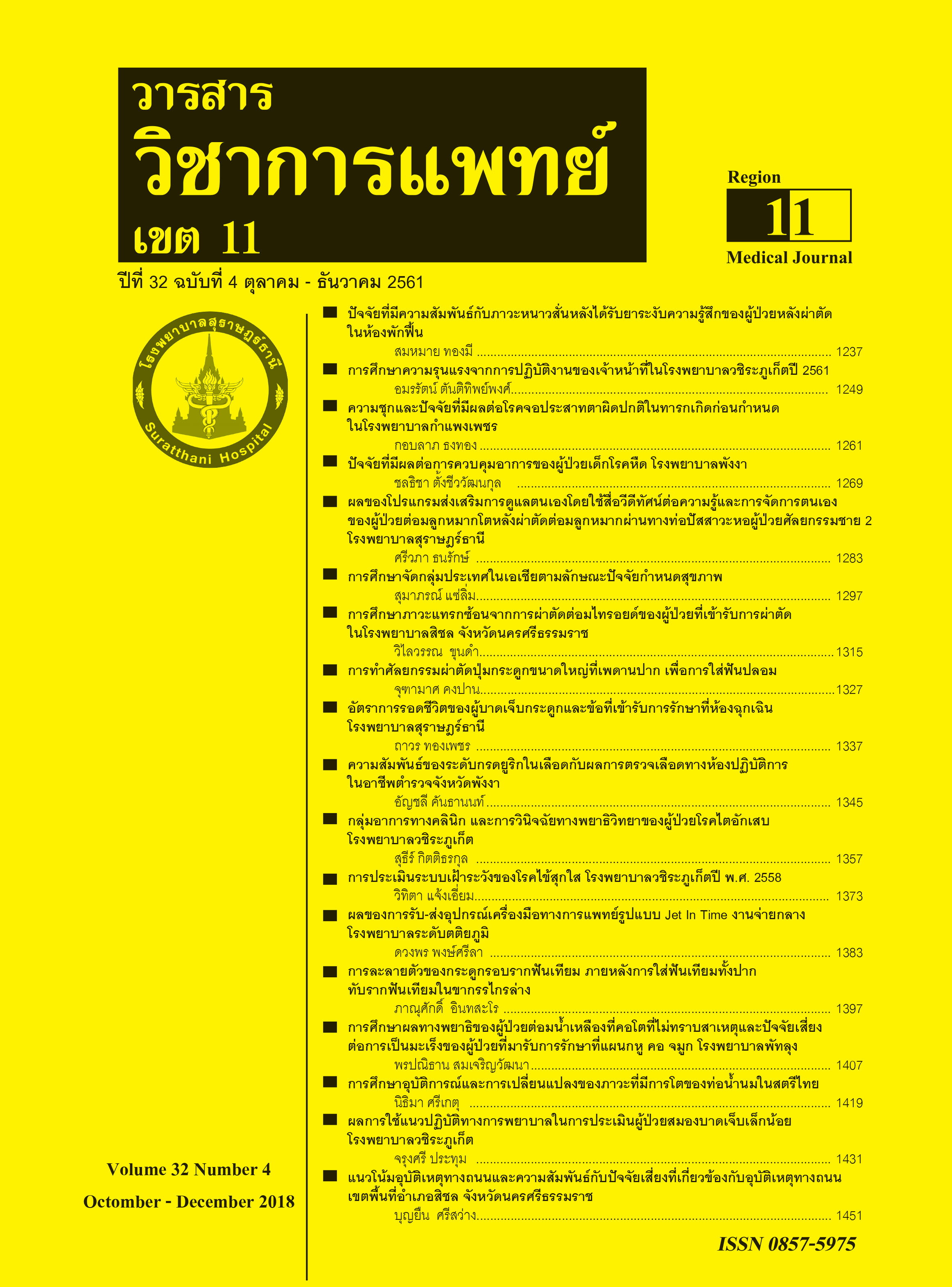ผลของการรับ-ส่งอุปกรณ์เครื่องมือทางการแพทย์รูปแบบ Jet In Time งานจ่ายกลาง โรงพยาบาลระดับตติยภูมิ
คำสำคัญ:
การรับและส่งอุปกรณ์เครื่องมือทางการแพทย์, Jet In Time, งานจ่ายกลางบทคัดย่อ
งานจ่ายกลางมีหน้าที่ทำให้อุปกรณ์เครื่องมือทางการแพทย์ปราศจากเชื้อเพื่อแจกจ่ายแก่หน่วยงานในโรงพยาบาล การรับส่งอุปกรณ์ฯ ที่ถูกต้อง มีประสิทธิภาพพร้อมใช้งาน และทันเวลา จะนำไปสู่ความปลอดภัยและความพึงพอใจของผู้รับบริการรวมถึงผู้ปฏิบัติงาน การศึกษาครั้งนี้เป็นการศึกษาวิจัยกึ่งทดลอง ชนิดหนึ่งกลุ่มเปรียบเทียบก่อน-หลัง มีวัตถุประสงค์เพื่อเปรียบเทียบความแตกต่างระหว่างรูปแบบเดิม(ก่อน) กับรูปแบบใหม่ Jet In Time (หลัง) ในเรื่อง (1) ผลของการรับและส่งอุปกรณ์เครื่องมือทางการแพทย์ด้านความถูกต้อง มีประสิทธิภาพพร้อมใช้งาน และทันเวลา(2) ผลการปฏิบัติตามแนวทางการรับส่งอุปกรณ์ฯ ของบุคลากร และ(3)ความพึงพอใจของบุคลากรกลุ่มตัวอย่างเป็นบุคลากรที่เกี่ยวข้องกับกระบวนการรับส่งอุปกรณ์ฯ ทั้งจากหน่วยงานที่บริการผู้ป่วยและจากงานจ่ายกลางวิเคราะห์ข้อมูลทั่วไปด้วยสถิติบรรยาย ส่วนการเปรียบเทียบความแตกต่างของตัวแปรผลลัพธ์ ใช้สถิติไค-สแควร์ และทีคู่ ขึ้นอยู่กับลักษณะตัวแปร
ผลการศึกษาพบว่าการรับส่งอุปกรณ์ฯ รูปแบบ Jet In Time มีความถูกต้องและทันเวลาสูงกว่ารูปแบบเดิมอย่างมีนัยสำคัญทางสถิติ (p<.05) ยกเว้นด้านประสิทธิภาพพร้อมใช้งาน บุคลากรปฏิบัติตามแนวทางการรับส่งอุปกรณ์ฯ ได้ถูกต้องเพิ่มมากขึ้นอย่างมีนัยสำคัญทางสถิติ (p<.05) และมีความพึงพอใจต่อการรับส่งอุปกรณ์ฯ รูปแบบ Jet In Time สูงกว่ารูปแบบเดิมอย่างมีนัยสำคัญทางสถิติ (p<.01)
เอกสารอ้างอิง
Wei-Lun, L., Hsueh-Wen, L., Mei-Feng, L.,Hsin-Lan, L, Yu-Hsiu, L, Chi-Chung, C.,et al. The impact of inadequate terminal disinfection on an outbreak of Imipenem-
resistant Acinetobacter baumannii in an intensive care unit 2014. [อินเตอร์เนต], 2559 เข้าถึงได้จาก : https://www.ncbi.nlm.nih.gov/pmc/articles/PMC4177873/
pdf/pone.0107975.pdf. [เข้าถึงเมื่อวันที่ 25 มกราคม 2560 ]
อะเคื้อ อุณหเลขกะ. หลักและแนวปฏิบัติในการทำลายเชื้อและการทำให้ปราศจากเชื้อ Principle and guideline for disinfection and sterilization. เชียงใหม่: มิ่งเมือง; 2554
ชมรมควบคุมโรคติดเชื้อในโรงพยาบาล.การป้องกันและควบคุมการติดเชื้อในโรงพยาบาล.[อินเตอร์เนต]. เข้าถึงได้จาก:http://wecache.googleusercontent.com/.[เข้าถึงเมื่อวันที่
5 มกราคม2560].
Toyota Seisan Houshiki wo Kangaeru kai. ระบบการผลิตแบบโตโยต้า (TOYOTA Production System). แปลและเรียบเรียงโดยมังกร โรจน์ประภากร. พิมพ์ครั้งที่ 5 กรุงเทพฯ:
ส.ส.ท.; 2553
สมฤดี กลิ่นหอม. การศึกษาเพื่อปรับปรุง ประสิทธิภาพ เพื่อลดต้นทุน และเพิ่มความสามารถในการให้บริการของบริษัท อิมเพรสเซอร์วิส จำกัด [วิทยานิพนธ์ปริญญาบริหารธุรกิจมหาบัณฑิต]. กรุงเทพฯ: มหาวิทยาลัยหอการค้าไทย; 2555. เข้าถึงได้จาก:http://eprints.utcc.ac.th/2673/2/2673fulltext.pdf. [เข้าถึงเมื่อวันที่ 25 กุมภาพันธ์2560 ].
จันทร์พิมพ์ เหล่าบำรุง. การลดจำนวนสินค้าส่งคืนเนื่องจากสาเหตุการเสียหายภายนอก :กรณีศึกษาอุปกรณ์เครื่องใช้ไฟฟ้าภายในครัวเรือน. [ออนไลน์], 2543. แหล่งที่มาจาก
:https://www.researchgate.net/publication.[สืบค้นเมื่อ 27 มีนาคม 2561].
ณัฏฐาสิริ ยิ่งรู้. ความสัมพันธ์ระหว่างสิ่งแวดล้อมในการทำงานและประสิทธิภาพการปฏิบัติงานของบุคลากรทางการแพทย์ : กรณีศึกษาโรงพยาบาลภูมิพลอดุลยเดช.(2555) [ออนไลน์].
เข้าถึงได้จากhttp://www.repository.rmutt.ac.th/bitstream/handle/123456789/1020/131773.pdf?sequence=1. [เข้าถึงเมื่อวันที่ 5 มีนาคม 2560]






